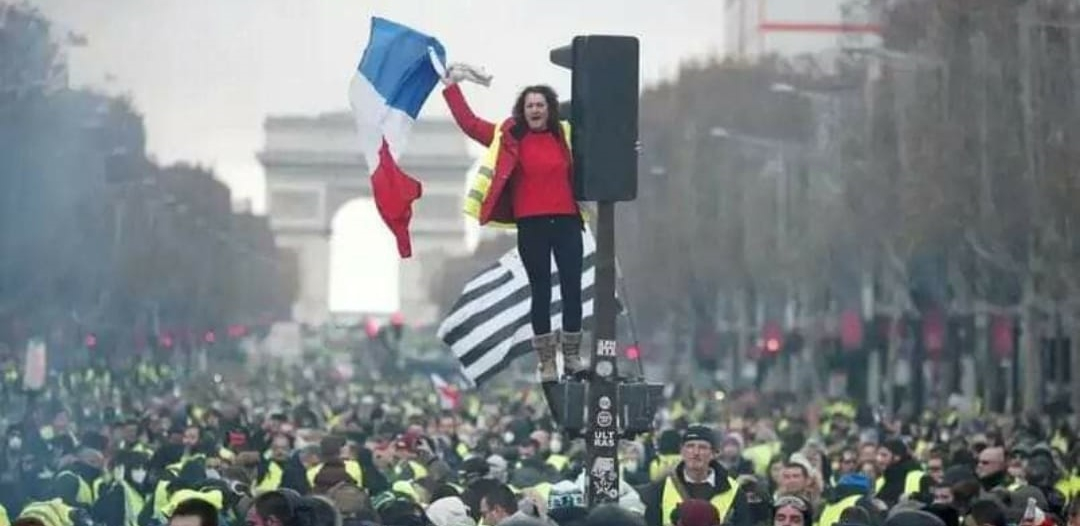Swept Up in France's Yellow Vest Protests

The movement originated out of resentment over a hike in the price of diesel gas, but this is no American-style TEA party. It's more like the Occupy movement. Photo: KRIS AUS67 (CC BY 2.0)
I’ve never been tear gassed before. The smell is similar to fireworks and the effect is explosive—and effective. I immediately wanted to get as far away as I could from the noxious source of burning eyes and throat.
I was in Paris when France’s “yellow vest” (gilet jaune) movement shut down the center of the city.
There were thousands of demonstrators, all wearing the bright yellow safety vests drivers are required by law to have in their cars.
They had come from all over the country. The Paris demonstration was the latest escalation in a leaderless movement organized by activists through social media.
The movement originated out of resentment over a hike in the price of diesel gas announced by President Emmanuel Macron as part of his efforts to address climate change. The price of gas in France is already the equivalent of $6.74 a gallon. Rural families dependent on vehicles would be stretched even further with the gas tax hike.
But this is no American-style Taxed Enough Already (TEA) party protest.
“These protests are not a backlash against the presence of the French state in the economy,” said Cole Stangler, a labor journalist who reports from Paris. “Many yellow vests are just asking that it act more fairly, infuriated by a government that asks them to give up more income each month at the same time as it grants tax cuts to the super-rich.”
The protesters represent a broad section of working-class France, and their anger is wholly understandable. While the French economy has recovered in the sense that business is booming, the standard of living for the average French family has not improved since the 2008 global economic collapse. Macron’s administration has doggedly pursued the interests of corporations and the rich, reducing taxes on the rich to the tune of billions of dollars per year.
Macron has also paved the way for companies to sidestep the sectoral agreements that set industry standards and protect workers, instead negotiating individual company contracts with unions. In an executive order, he made it easier to fire workers—and thousands have been terminated as a result. Unions claim that companies are seizing the chance to expel senior, higher-paid workers and fill those positions with younger, lower-paid replacements. Macron claims these changes are necessary to address high unemployment—it has stood at over 9 percent for a decade—by further shifting the balance of power away from workers, towards employers.
MASS DISRUPTION
The protest began at the Arc de Triomphe and commenced down the Champs-Élysées, Paris’s most opulent commercial boulevard right in the heart of the city.
This was a demonstration that intended to be heard. Mass disruption was the goal—no more business as usual.

SUPPORT LABOR NOTES
BECOME A MONTHLY DONOR
Give $10 a month or more and get our "Fight the Boss, Build the Union" T-shirt.
Protesters shattered windows and set fire to construction vehicles and food stands. Entire sections of the cobblestone street were missing, as if a giant had rolled up the road and walked off with it for a living room rug.
The protesters had wielded stones, but the riot police had armor, shields, batons, and guns. And lots of tear gas.
The demonstration fanned out through central Paris as the police fired can after can into the crowds and the streets became shrouded in a fog of poison.
Police and demonstrators reached standoffs in some of the small side streets that Paris is known for.
Lines of militarized police stood behind makeshift fencing they erected on one end of a boulevard while protesters gathered around fires they set in the middle of the road at the opposite end.
Tourists caught in the middle and trying to get out were frustrated in their attempt as central Paris became a maze of impassable streets.
MACRON CAVES
According to polling in France, the yellow vest movement is supported by two-thirds of the public. This stands in sharp contrast to Macron, whose approval rating is barely above 20 percent.
Feeling the heat from the barricades, Macron announced this week that the tax hikes will not be enacted in 2019.
The future of the yellow vest movement is less clear.
As with the leaderless Occupy movement in the U.S. in 2011, major union confederations haven’t backed France’s movement, but local unions have turned out members and their sympathizers to the yellow vest protests.
“Meanwhile, militant railroad workers in Paris—many of the same ones who went on rolling strikes last spring over reforms that undermined their job security—have organized a yellow vest solidarity march this weekend,” said Stangler.
“There is anger and a willingness to keep protesting without a clear set of demands. Labor, left and student activists all hope to turn the movement in a more progressive direction.”






